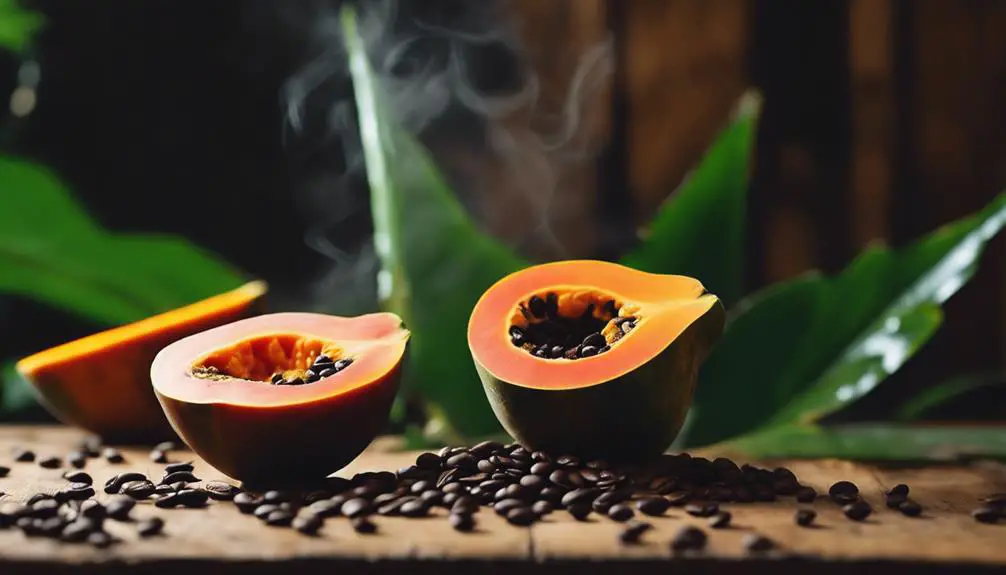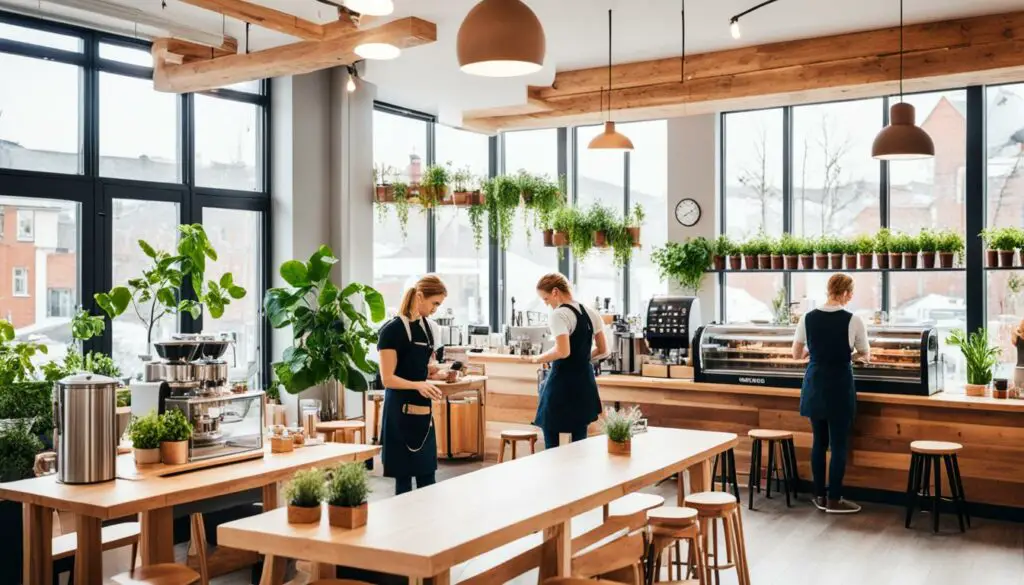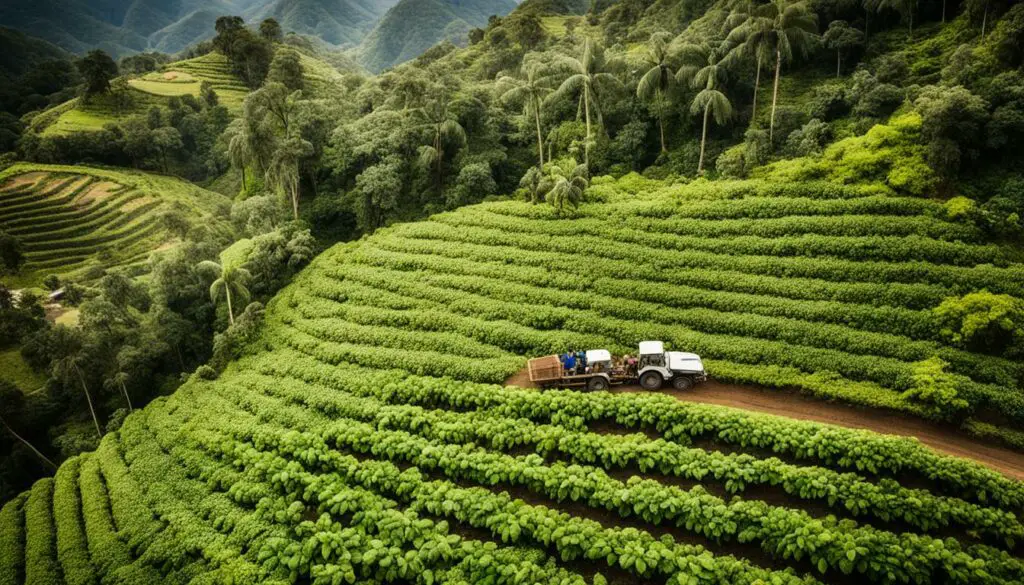Finding the ideal pour-over coffee ratio is crucial for brewing the perfect cup of coffee. Using a consistent coffee-to-water ratio is recommended, with a general rule of 1:17 (coffee-to-water weight ratio). For example, for a Chemex, you would use 42 grams of coffee and approximately 700 grams of water. However, it’s important to note that the ratio can be adjusted to taste. If the coffee tastes weak or sour, a finer grind is recommended, and if it tastes too bitter, a coarser grind is recommended.
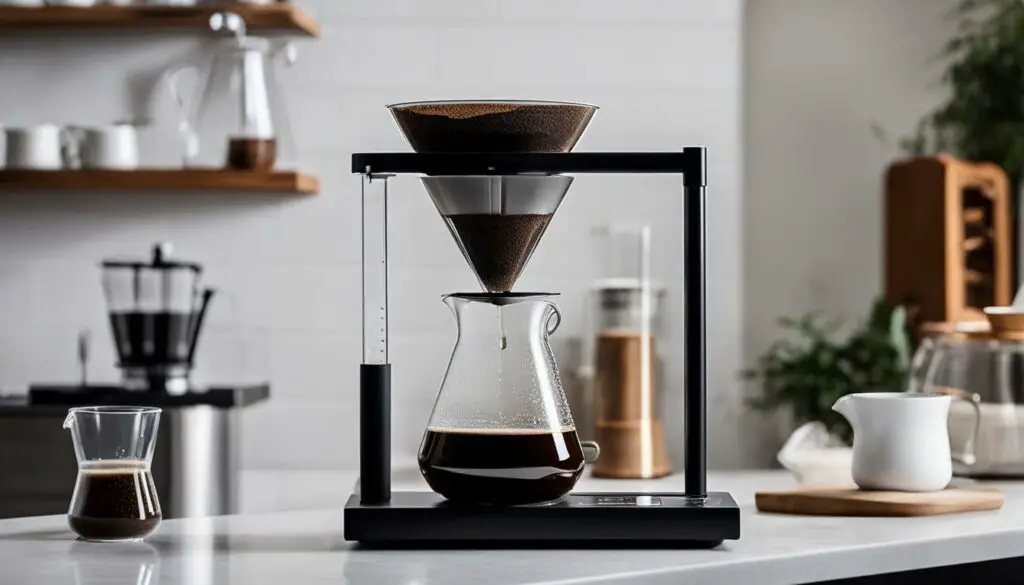
Key Takeaways:
- Finding the right ratio of coffee to water is crucial for brewing a perfect pour-over coffee.
- The general rule is a 1:17 coffee-to-water weight ratio, but it can be adjusted to taste.
- A finer grind is recommended for a weak or sour-tasting coffee, while a coarser grind is recommended for a bitter taste.
Importance of Freshly Ground Coffee
Grinding your coffee right before brewing is essential for a fresh and flavorful cup of pour-over coffee. Once coffee is ground, it starts to oxidize and age, which can affect the taste. It is recommended to use a burr grinder for a consistent grind size. The size of the grind particles also plays a role in the extraction process, so finding the proper grind size for your pour-over method is important. If you don’t have a grinder at home, you can ask your local specialty coffee shop to grind the coffee for you, specifying the type of brew device you’ll be using.
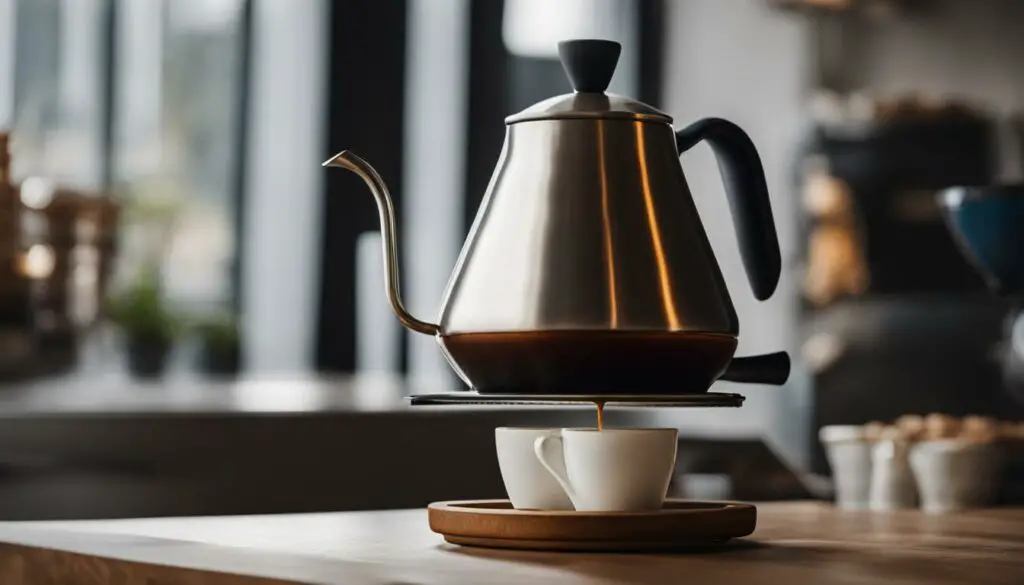
Did you know?
Grinding coffee beans releases aromatic oils that intensify the flavors and aromas of the coffee. These oils quickly dissipate when exposed to air, so grinding your coffee just before brewing ensures that you capture the fullest, freshest flavors in your pour over coffee.
The Role of Coffee Oxidation
Coffee oxidation is a natural process that occurs when coffee beans are exposed to air. Once the beans are ground, the surface area increases, accelerating the oxidation process. This oxidation can lead to a loss of flavor and aroma, resulting in a less satisfying cup of coffee. By grinding your coffee beans just before brewing, you can minimize oxidation and preserve the freshness of the coffee.
| Grind Size | Extraction Rate | Taste Profile |
|---|---|---|
| Coarse | Low | Mild, under-extracted |
| Medium | Medium | Balanced, well-extracted |
| Fine | High | Intense, potentially over-extracted |
Table: Coffee Grind Sizes and Taste Profiles
As the table illustrates, the grind size plays a significant role in the extraction rate and taste profile of the coffee. A finer grind size allows for a higher extraction rate, resulting in a more intense flavor that could potentially be over-extracted. On the other hand, a coarser grind size leads to a lower extraction rate and a milder taste profile that may be under-extracted. Finding the right grind size for your pour-over method can help you achieve the desired flavor balance.
The Art of the Pour
Pouring the water correctly is an art in itself when it comes to pour over coffee. The technique used can greatly impact the flavor and quality of the final brew. Let’s dive into the key elements of the pour over technique, including the bloom pour and the importance of a pour-over kettle.
Bloom Pour
The first pour in the pour-over method is called the bloom pour. This step involves saturating all the coffee grounds to prepare them for an even extraction. To achieve this, pour about twice the amount of water as coffee and gently stir to ensure all the grounds are fully saturated.
During the bloom pour, you’ll notice the coffee grounds releasing gases, resulting in a beautiful bloom with a fragrant aroma. This process helps to degas the coffee and sets the stage for an even extraction.
By pouring the water in a circular motion, starting from the center and gradually moving towards the edges, you can ensure that all the coffee grounds are evenly saturated. This helps to promote consistent extraction and a balanced flavor profile in the final cup.
Pour Over Kettle
Using a pour over kettle can greatly enhance your pour over technique. A gooseneck spout allows for precise control over the water flow, ensuring accuracy and consistency in pouring. This is especially important when it comes to the subsequent pours after the bloom pour.
A gooseneck kettle allows you to pour the water slowly and steadily, in a spiral motion, maintaining a consistent flow rate. This helps to prevent over-extraction or channeling, which can lead to a less flavorful cup of coffee.
Investing in a high-quality pour over kettle is worth considering if you’re serious about perfecting your pour over technique. Look for kettles with a gooseneck spout and a comfortable handle for ease of use.

| Pour Over Technique Tips |
|---|
| Use a gooseneck kettle for precise pouring |
| Pour the water in a spiral motion to maintain consistency |
| Gently stir the bloom pour to ensure even saturation |
| Experiment with different pouring speeds to find the right balance |
| Practice patience and take your time during the pouring process |
Mastering the art of pour-over coffee brewing takes practice, but it’s well worth the effort. By understanding the bloom pour and using a pour-over kettle, you can refine your technique and achieve consistently delicious cups of pour-over coffee. So grab your kettle, perfect your pouring skills, and enjoy the rewarding experience of brewing your own pour-over coffee!
The Role of Water in Pour Over Brewing
Pour-over coffee is a delicate process that relies on the interaction between coffee grounds and water to extract the desired flavors. However, the quality of water used in this brewing method is often overlooked but plays a vital role in the final taste of the coffee.
When it comes to pour-over brewing, the water temperature is crucial. The ideal water temperature for brewing is around 205 degrees Fahrenheit, or about 30 seconds off the boil. This temperature allows for optimal extraction without scorching the coffee grounds. Using water that is too hot can lead to over-extraction and a bitter taste, while using water that is too cold can result in under-extraction and a weak, bland cup of coffee.
Not only is the temperature important, but the cleanliness of the water is also crucial. Using water that you would drink, free from any impurities or odors, ensures that no unwanted flavors are introduced to the coffee. This is especially important in pour-over brewing, where the flavors of the coffee are showcased and any off-flavors in the water can be easily detected.
Benefits of Using Filtered Water:
- Removes impurities: A good water filter can remove impurities such as chlorine, heavy metals, and other contaminants that can affect the taste of the coffee.
- Enhances clarity: Filtered water can improve the clarity of the flavors in the coffee, allowing you to fully appreciate its nuances.
- Prevents scale buildup: If your tap water is hard, using filtered water can help prevent mineral buildup in your pour-over equipment, ensuring optimal performance and longevity.
By paying attention to the role of water in pour-over brewing and using clean and high-quality water at the right temperature, you can elevate your pour-over coffee brewing and enjoy a more flavorful and enjoyable cup of coffee.
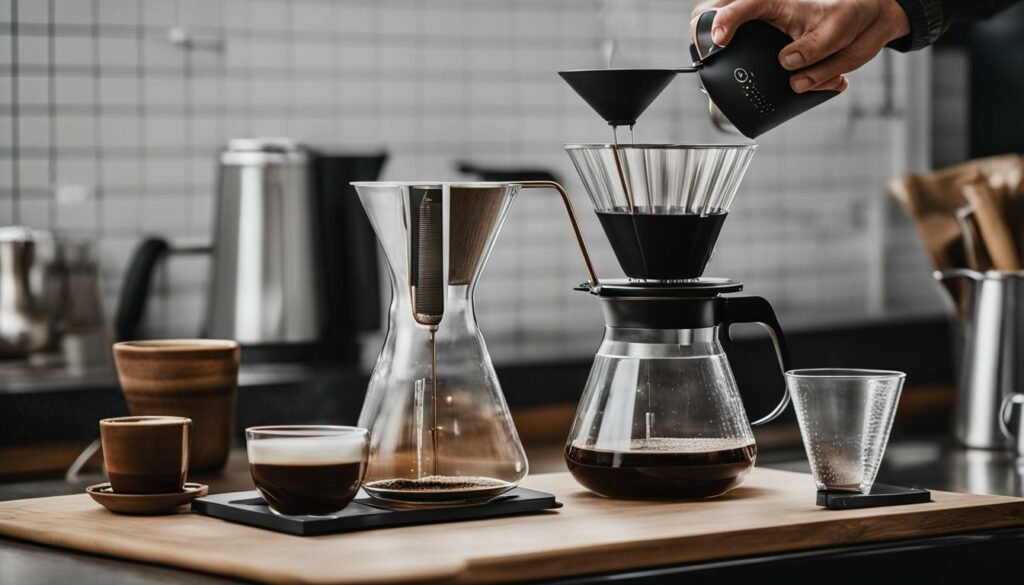
Exploring Different Pour Over Methods
When it comes to pour over coffee, there are different brewing methods to suit various tastes and preferences. Let’s take a closer look at three popular pour over brewing methods: V60, Chemex, and Kalita Wave.
V60
The V60 pour over method, named after its V-shaped cone, is known for its versatility and ability to produce a clean and crisp cup of coffee. This method requires a medium to fine grind size and a specific pouring technique. The coffee grounds are placed in a paper filter inside the V60 dripper, and hot water is poured in a spiral motion, allowing for maximum extraction and control over the brewing process.
Chemex
The Chemex pour over method is favored for its visually appealing design and its ability to produce a rich and full-bodied cup of coffee. It utilizes a thicker paper filter and a coarser grind size compared to the V60.
The coffee grounds are placed in the Chemex filter, and hot water is poured in a slow and steady manner, resulting in a longer brew time. The Chemex brewing method offers a smooth and well-balanced flavor profile.
Kalita Wave
The Kalita Wave pour over method is known for its consistent extraction and evenness in flavor. It features a flat-bottomed dripper with small holes and requires a medium grind size. The coffee grounds are evenly distributed in the Kalita Wave filter, and hot water is poured in a slow and controlled manner. The design of the Kalita Wave dripper encourages a balanced extraction, resulting in a clean and nuanced cup of coffee.
| Method | Coffee to Water Ratio | Grind Size | Key Features |
|---|---|---|---|
| V60 | 1:16 | Medium to Fine | Versatile, clean and crisp cup |
| Chemex | 1:15 | Coarse | Rich and full-bodied flavor |
| Kalita Wave | 1:17 | Medium | Consistent extraction, clean and nuanced cup |
Pour Over Coffee Tools
When it comes to brewing the perfect cup of pour-over coffee, having the right tools can make all the difference. Here are some essential pour-over coffee tools that will enhance your brewing experience:
Coffee Grinder
A quality coffee grinder is essential for grinding fresh coffee beans right before brewing. Investing in a burr grinder ensures a consistent grind size, which is crucial for even extraction. With a grinder, you have control over the grind size, allowing you to customize your pour-over coffee to your preferred taste.
Pour Over Brewer
Choosing the right pour-over brewer, such as a V60 or Chemex, can greatly impact the flavor and aroma of your coffee. These brewing devices are designed to optimize water flow and extraction, resulting in a clean and vibrant cup of coffee. Experiment with different brewer styles to find the one that suits your brewing style and taste preferences.
Coffee Scale
A coffee scale is an essential tool for precise measurements in pour over brewing. Consistency is key when it comes to achieving the perfect coffee to water ratio, and a scale ensures accurate measurements every time. By measuring the coffee and water in weight, you can maintain consistency and achieve the desired flavor profile in your pour over coffee.
By using these pour over coffee tools, you can take your brewing to the next level and unlock the full potential of your pour over coffee. With attention to detail and precision, you’ll be able to consistently brew delicious cups of pour over coffee that will delight your taste buds.
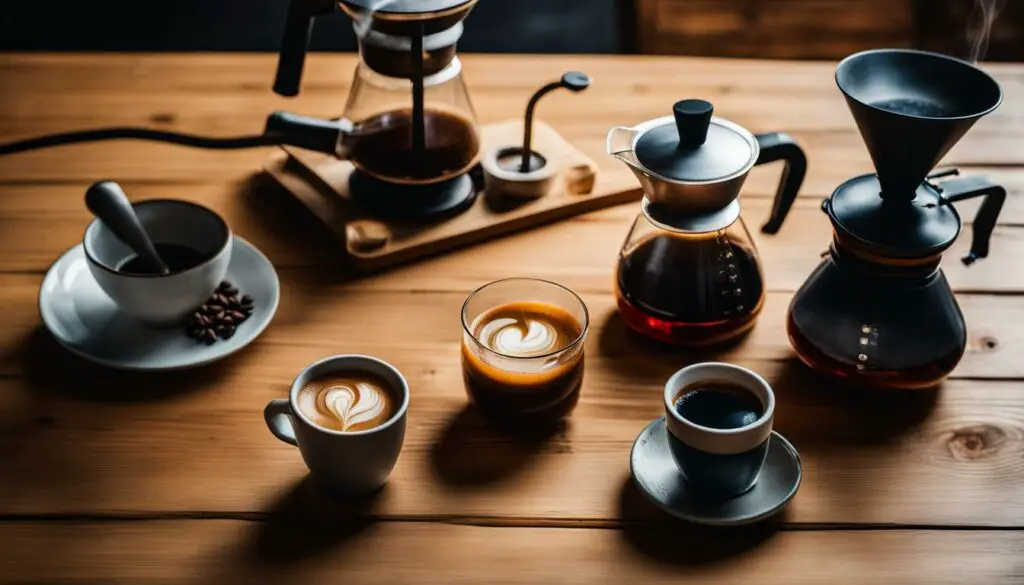
Finding the Right Grind for Your Pour Over
Finding the perfect grind size is key to achieving the desired flavor and extraction in your pour over coffee. A medium grind consistency, similar to table salt, is generally recommended as a starting point for most pour over methods. This grind size allows for a balanced extraction, capturing the flavor notes of the coffee without over or under extracting.
However, it’s important to note that the ideal grind size may vary depending on the pour over method and personal preference. For example, a finer grind is often used for methods like the V60 to achieve a brighter, more vibrant flavor, while a slightly coarser grind may be preferred for the Chemex to highlight the coffee’s body and richness.
To find the right grind size for your pour over, it’s best to start with a medium grind and make adjustments based on taste. If the coffee tastes bitter, it may indicate that the grind is too fine, resulting in over-extraction. Conversely, if the coffee tastes weak or sour, the grind may be too coarse, leading to under-extraction. Experimentation is key to finding the sweet spot that suits your preference.

Table: Grind Size Recommendations for Different Pour Over Methods
| Pour Over Method | Grind Size |
|---|---|
| V60 | Medium-Fine |
| Chemex | Medium-Coarse |
| Kalita Wave | Medium |
Remember, achieving a consistent grind size is just as important as finding the right size. Uneven grinds can result in an uneven extraction, leading to an imbalanced cup of coffee. Investing in a quality burr grinder can help ensure a consistent grind size, allowing you to have more control over the brewing process.
Pour Over Brewing Step-by-Step Guide
Mastering the art of pour over coffee brewing requires a systematic approach. Follow this step-by-step guide to achieve a delicious cup of pour over coffee:
- Rinse and preheat: Begin by rinsing the filter with hot water to remove any paper residue and preheat the brewer. This ensures a clean taste and proper temperature stability.
- Add coffee: Add freshly ground coffee to the brewer, creating a level bed of coffee. The amount of coffee used will depend on your desired strength and the coffee to water ratio you prefer.
- Bloom pour: Start with the bloom pour by pouring about twice the amount of water as coffee. This step allows the coffee to degas and release any trapped carbon dioxide for a better extraction. Gently stir the coffee to fully saturate it.
- Main pour: Pour the remaining water slowly and steadily in a spiral motion, starting from the center and moving outward. This helps distribute water evenly and ensures proper extraction. Aim to maintain a consistent flow and avoid pouring too fast or too slow.
- Filter and serve: Allow the water to filter through the coffee bed, ensuring a complete brew time of around 3 minutes and 30 seconds to 4 minutes. Once the brew is complete, give the brewer a slight swirl to level the grounds and maintain a flat coffee bed. Now, your freshly brewed pour over coffee is ready to be enjoyed!
Remember, the pour over technique is an art that can be refined over time. Experiment with different coffee beans, grind sizes, water temperatures, and pour speeds to find the perfect combination that suits your taste preferences. Enjoy the process and savor the rich flavors of a well-brewed cup of pour over coffee!
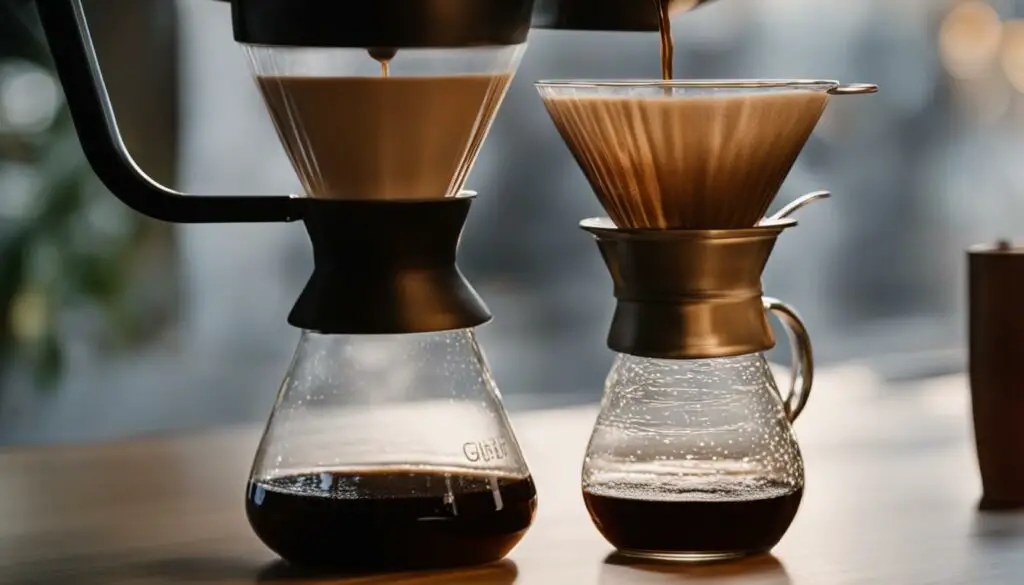
Summary Table: Pour Over Brewing Steps
| Steps | Description |
|---|---|
| Rinse and preheat | Rinse the filter and preheat the brewer with hot water |
| Add coffee | Add freshly ground coffee to the brewer |
| Bloom pour | Pour twice the amount of water as coffee to degas the coffee grounds and stir gently |
| Main pour | Pour the remaining water slowly and steadily in a spiral motion |
| Filter and serve | Allow the water to filter through the coffee bed and give the brewer a slight swirl before serving |
Tips for Making Better Pour Over Coffee
Want to take your pour over coffee brewing to the next level? We’ve got you covered with some expert tips and tricks to help you perfect your technique and enhance the flavor of your brew. Whether you’re a beginner or a seasoned pour over coffee enthusiast, these tips will help you achieve a delicious cup of coffee every time.
Experiment with Different Pour Over Methods and Ratios
One of the best things about pour over coffee is the versatility it offers. Don’t be afraid to experiment with different pour over methods such as the V60, Chemex, or Kalita Wave, and adjust the coffee to water ratios to suit your taste. Each method has its own unique characteristics and can produce different flavor profiles. By exploring different methods and ratios, you can find the combination that best suits your preferences.
Explore Longer Brew Times and Adjust Grind Size
The extraction process in pour over brewing can be influenced by the brew time and grind size. If you’re looking to intensify the flavor of your coffee, try extending the brew time slightly. Conversely, if you prefer a lighter and more delicate brew, a shorter brew time may be preferable. Additionally, don’t hesitate to adjust the grind size to fine-tune the extraction. Finer grind sizes can enhance the brightness of the coffee, while coarser grind sizes can bring out more subtle flavors.
Use Freshly Roasted Coffee Beans
The quality of the coffee beans you use has a significant impact on the taste of your pour over coffee. Opt for freshly roasted beans to ensure maximum flavor and aroma. Coffee beans start to lose their freshness and flavor shortly after roasting, so it’s best to consume them within a few weeks of the roast date. Look for local specialty coffee roasters or reputable online sources that provide freshly roasted beans for the best results.
| Tips for Making Better Pour Over Coffee |
|---|
| Experiment with different pour over methods and ratios |
| Explore longer brew times and adjust grind size |
| Use freshly roasted coffee beans |
| Maintain consistency in your brewing technique |
| Enjoy the process of brewing your own pour over coffee |
Conclusion
In conclusion, perfecting the art of pour over coffee brewing is a journey that requires attention to detail and experimentation. By understanding the importance of the coffee to water ratio, grind size, pouring technique, and other variables, you can elevate your pour over coffee to new heights.
With practice and experience, you can achieve pour over coffee mastery and consistently brew exceptional cups of coffee at home. Remember to follow the recommended guidelines, but don’t be afraid to experiment and make adjustments to suit your personal taste preferences.
So, whether you prefer a V60, Chemex, or Kalita Wave, take the time to perfect your pour over brewing technique. Embrace the process and enjoy the journey towards the perfect cup of pour over coffee. With a little patience and dedication, you’ll be savoring the rich flavors and aromas of your homemade pour over coffee in no time.
FAQ
What is the recommended coffee to water ratio for pour over brewing?
The general rule is a 1:17 coffee to water weight ratio. For example, for a Chemex, you would use 42 grams of coffee and approximately 700 grams of water. However, the ratio can be adjusted to taste.
Why is grinding coffee right before brewing important for pour over coffee?
Grinding coffee right before brewing ensures a fresh and flavorful cup. Once coffee is ground, it starts to oxidize and age, which can affect the taste. It is recommended to use a burr grinder for a consistent grind size.
How should water be poured in pour over brewing?
The first pour, known as the bloom pour, involves saturating all the coffee grounds. Pouring about twice the amount of water to coffee and stirring gently is recommended. Subsequent pours should be slow and steady, in a spiral motion.
What type of water should be used for pour over brewing?
It is recommended to use water that you would drink, as it directly affects the taste of the coffee. The ideal water temperature for brewing is around 205 degrees Fahrenheit or about 30 seconds off the boil.
What are the popular pour over brewing methods?
The most popular pour over brewing methods include V60, Chemex, and Kalita Wave. Each method has its own recommended coffee to water ratios and unique characteristics.
What tools are essential for pour over coffee brewing?
Essential tools include a quality coffee grinder, a pour over brewer such as a V60 or Chemex, a gooseneck kettle for precision pouring, and a coffee scale for accurate measurements.
What is the ideal grind size for pour over coffee?
A medium grind consistency, similar to table salt, is generally recommended as a starting point. However, the ideal grind size may vary depending on the pour over method and personal preference.
What is the step-by-step process for brewing pour over coffee?
First, rinse the filter and preheat the brewer. Then, add freshly ground coffee and begin with a bloom pour. Follow with slow and steady pouring in a spiral motion. Wait for the water to filter through, and give the brewer a slight swirl at the end.
How can I make better pour over coffee?
Experiment with different pour over methods, ratios, and water temperatures to discover your preferred taste. Use freshly roasted coffee beans, maintain consistency in your brewing technique, and have fun exploring and experimenting.
How can I master the art of pour over coffee brewing?
By following the recommended guidelines, practicing consistently, and experimenting with different variables, you can unlock the secrets to the perfect cup of pour over coffee. With time and experience, you’ll be able to consistently brew exceptional pour over coffee at home.










